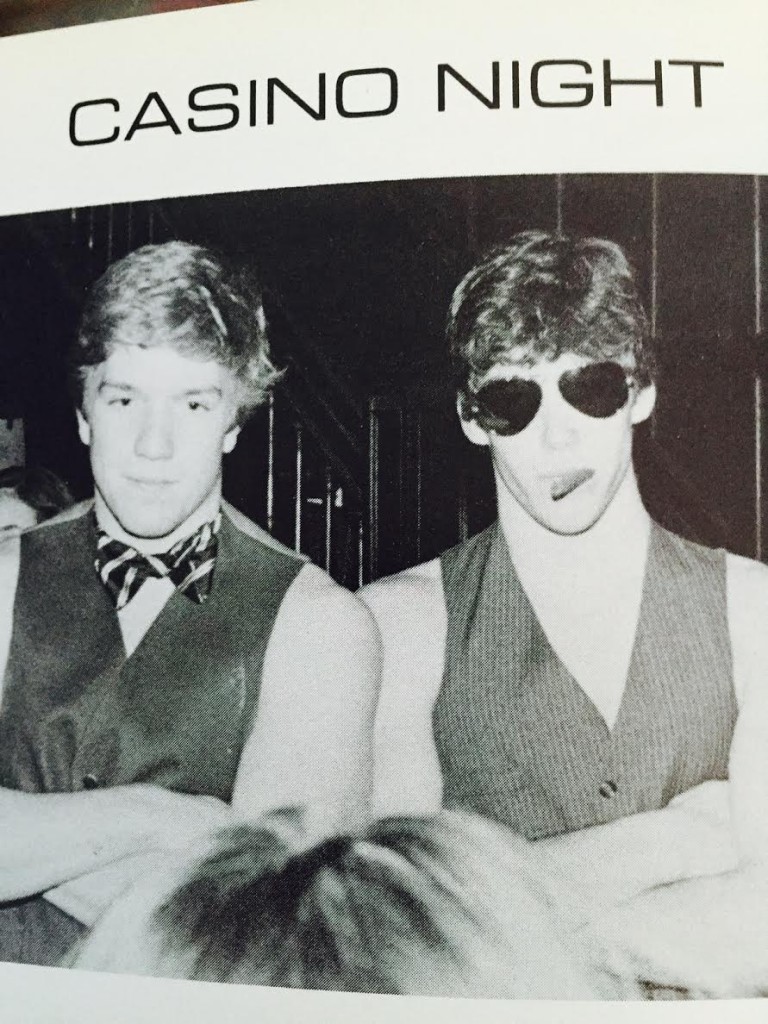Image from the 1984 St. George’s School yearbook. The same yearbook has a photo of girls in bunny costumes holding serving trays.
The independent investigation of sexual abuse at St. George’s School released yesterday includes details of second class treatment of girls at the school when it became co-ed in the 1970s. From the report:
Students also described a culture that objectified women. “Casino Night,” a social event for students and faculty, is a striking example of that. Beginning shortly after girls were admitted, new female students (in either the ninth or tenth grade) served as “bunnies,” an ostensible honor that required that they don Playboy costumes—leotards, bunny tails, and ears—and act as servers for the predominantly male student body and faculty who enjoyed casino games as the girls dispensed fake cigarettes and cigars. Faculty were, obviously, aware of the event, as they were in attendance; in addition, at least some students recalled that Dolly Howard, then Dean of Female Students, may have held onto the bunny costumes and accessories year-to-year and distributed them to the female students. This was a tradition that continued at the school into the mid-1980s, and while some specifics appear to have changed (for example, some recall that all new students wore the costumes, while others recall that girls were selected based on perceived attractiveness), the basic premise remained that female students served as scantily clad “bunnies.”
…
Some female students recounted open hostility from faculty, including direct statements that St. George’s was a boys’ school and other statements suggesting that female students were not qualified to be there. In the college admissions process in particular, many recounted that they were denigrated by administrators like William Schenck, Dean of the Faculty, and felt their college choices were subordinated to male students’ (for instance, being encouraged to apply to less competitive schools if a female student presented a threat to a male student’s chance of admission).
…
Witness 16 was raped by a male student during the summer of 1979, the summer before her junior (fifth-form) year. The student rapist was in the Class of 1980, one year ahead. Her first interaction with the perpetrator came at Casino Night the prior fall. Witness 16 recalls a female faculty member giving her and other new girls playboy bunny costumes, which the girls had to wear throughout the event (which was attended by faculty as well as students). Witness 16 recalls being cold and uncomfortable in the costume. That night, the perpetrator approached Witness 16 and tried to get her to leave the event with him. She declined….
Casino Night remains, though it does not happen yearly; importantly, it bears little resemblance to the Casino Night of the past. Now, the focus is on the mock casino games played by all students, not on objectifying and degrading young women as “bunnies.”
…
There were still other more implicit ways in which the school’s often confused or inattentive response to its new female students may have enabled [athletic trainer] Gibbs’ abuse and misconduct. St. George’s was a school that had been, since its inception in 1896, led by, taught by, and comprised of men. At least at the outset of co-education, through the 1970s and into the 1980s, St. George’s seems to have given preference to male students at the expense of female students. Many of the women with whom we spoke reported that they did not perceive any support from the school. Many women viewed themselves (and appear to have been viewed) as “token” female students, as something ancillary to the male student body (and the numbers may support this—given that they were outnumbered three-to-one). As a result, many women stated that there were no faculty or staff they felt comfortable approaching to discuss abuse (by Gibbs or others) or, even more basically, their feelings of unease or discomfort. In fact, some women noted that they believed there would be adverse consequences for them had they reported certain abuse. In their conversations with us, women in these early classes wondered, almost invariably, how it was that no adult appeared to recognize that Gibbs’ public behavior toward girls was inappropriate and why no one intervened.
The negative climate for the early co-ed cohorts extend beyond objectification and abuse:
Some female students recounted open hostility from faculty, including direct statements that St. George’s was a boys’ school and other statements suggesting that female students were not qualified to be there. In the college admissions process in particular, many recounted that they were denigrated by administrators like William Schenck, Dean of the Faculty, and felt their college choices were subordinated to male students’ (for instance, being encouraged to apply to less competitive schools if a female student presented a threat to a male student’s chance of admission).

